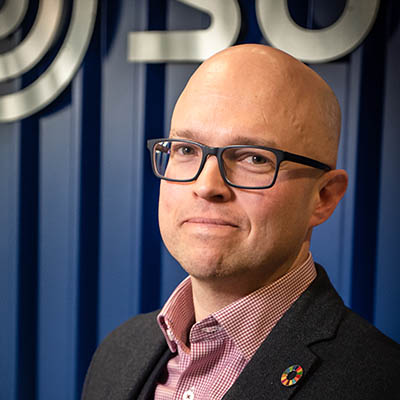SUEZ site-seeing | Part 19 | Local authority collection round in Calderdale

Since the launch of the SUEZ recycling and recovery UK’s Resources & Waste Management Manifesto in late May, I have been somewhat busy facilitating workshops with DEFRA, key stakeholders, and some of our clients to test some of our assumptions and work through some of our recommendations in more detail.
After the workshops that we hosted in Leeds, I decided that rather than travelling back south after, I would stay in Yorkshire and visit one of the few contracts I had yet to see on my tour of SUEZ sites in the UK. Our depots in Halifax service over 90,000 households with a range of collection services across the Calderdale District.
SUEZ has been Calderdale’s waste contractor since 2008, successfully re-tendering the collection service in 2016, and we are now two years into our eight year contract. The depot is small, but it houses a fleet of approximately 40 collection vehicles providing general waste, recycling, green waste and bulky waste collections. The service involves weekly food waste and dry mixed recycling collections using Romaquip vehicles (as in East Devon, but this is a very different borough) and a fortnightly collection of residual waste – around 35% of collections are in black sacks as there is little room at the kerbside for wheelie bins in some areas.
Every household is provided a white hessian sack to collect their cans and plastics (which are sorted at our nearby Kirklees materials recycling facility, MRF) a 23 litre food caddy (with a 5 litre caddy for use inside the home), a heavy duty and durable green plastic sack for paper and grey cardboard (cereal boxes etc.) and a black recycling box for cardboard and glass. The crew does the sorting at the kerbside and the quality of the materials is good, although there is a recurring problem with glass bottles in the black box which can’t always be seen when doing a visual check before loading the vehicle, and 20% of the mixed paper and card flow is contaminated to some degree by glass shards, which together with the Council we are addressing through ongoing communications with local residents.
However, things are never as simple as they seem, and after a short tour with the Senior Contract Manager, it was obvious why so many different vehicles were being used to deliver the service. Calderdale is one of the UK’s larger districts, but the population is concentrated along the Calder Valley, whilst the rest of the district is rural, very hilly and sparsely populated. As such, there is a need not only for narrow access vehicles to deal with the cobbled streets, the steep inclines and the densely packed urban areas, but also the use of adapted Isuzu Land Rovers to enable the remote farmhouses and hillside residences to be serviced each week – for both recycling and residual waste. These adapted trucks are better suited to the difficult terrain but still provide the same stillage compartments as the larger Romaquip recycling trucks, ensuring a similar service provision is delivered to every house! Even the multi-occupancy and high-rise properties get a service, but their recycling is commingled because of space restrictions and this is taken directly to Kirklees for sorting at the MRF.
In 2017/18 over 17,000 tonnes of recyclables were collected, processed and sent to end markets. In addition to this 37,000 tonnes of residual waste was collected and taken to a local site for fuel preparation prior to onward movement to the Ferrybridge Power Station, delivering a 31% recycling rate.
Given the housing stock, the road network and storage constraints this seemed pretty good! Although it has dropped a little in recent years, but not because the residual levels are increasing, but because paper levels have reduced as the local daily newspaper has moved online.
It was great to see one of our more ‘earthy’ sites working, and to spend a few hours with the front line employees as they negotiated their way around the narrow streets, poor access areas, and on-street parking issues that they regularly face in Halifax and the surrounding countryside.
The teams work hard, even when stuck on a sharp incline trying to reach a single house with no recycling out for collection, something you wouldn’t know until you got to the end of their drive, some 500 metres or more from the last pick-up!
The crew have been working closely with the client team for many years, and the sense of partnership and ‘camaraderie’ was clear to see. Whether it be responding to a fly tipping issue, addressing glass contamination in certain parts of the town, to making the most of the site, which is quite central and tight for access on all sides. I was fascinated to find out that the site handles so manye lorry movements on such a small footprint, requiring a great deal of active traffic management and day-to-day maintenance to get vehicles in, turned around, and out again in minimal time.
Things aren’t easy, but everyone is pulling together and the job is getting done, so well done to the team for the unsung work they do on behalf of the residents of Calderdale Borough Council. And just for the record, the site induction was spot on, and the knowledge of the staff was very impressive, which is what I am now expecting from every site that I visit!
My site visits will be quieting down now for a while, what with the ongoing stakeholder engagements planned around our manifesto and the work of DEFRA on the new Waste & Resources Strategy which is due out in the winter, but all the hard lifting is being done now. But I am planning to head to the north east to check out a number of sites, services and solutions – so watch this space!